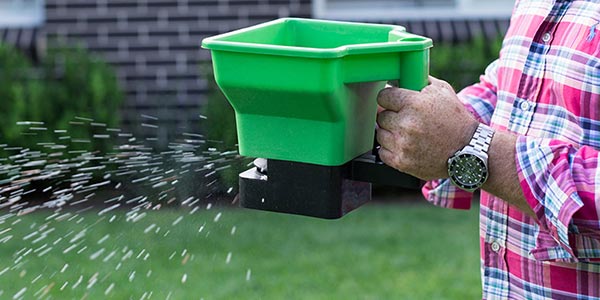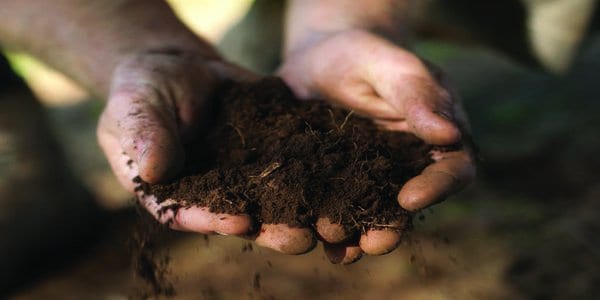Lawn Aeration Guide
Inside this article
- What is lawn aeration
- Why do we recommend aeration of lawn?
- When should you aerate?
- How often should lawn aeration be done?
- How to aerate your lawn
- Extra tips to improve your soil
What is lawn aeration?
Aeration is the process of breaking up the soil beneath your grass to allow air, water and nutrients to penetrate the roots.

Why do we recommend aeration of lawn?
Your grass needs space in the soil to absorb water and nutrients which enables it to perform at its best. Aeration helps the roots to grow down deep and produce a dense and thriving lawn. The main reason to aerate is to fix soil compaction.
Compaction usually means the soil has too many solid parts in a certain space, which prevents the circulation of air, water and nutrients within the soil. Aerating the soil helps to prevent many other common lawn problems such as bare patches, weeds, dryness and issues with drainage.
When should you aerate your lawn?
The best time to aerate warm-season grass varieties such as Sir Walter DNA Certified, TifTuf Hybrid Bermuda, Zoysia Australis, Eureka Kikuyu or Sir Grange Zoysia is during spring and summer while they are in their active growth stage.
When should you aerate your lawn?
It’s not recommended to aerate in the cooler months of the year as the recovery time of the grass will be quite prolonged, and your lawn will struggle to keep up with the added stress of an aeration.
Always try to aerate at the same time you are fertilising or performing any other major lawn care operation such as dethatching and top dressing. Such activities are best performed in the active growing seasons (for most areas is mid-to late spring & summer).
How often should lawn aeration be done?
Depending on your soil type and lawn use, you may need more frequent aeration. If you have a heavy clay base the soil will generally become compacted more easily and should be aerated at least once a year.
For a sandy lawn, you can aerate once a year, or once every two years. If you live in harsher climates, it may be a good idea to aerate twice a year to encourage turf growth and health.
Traffic on your lawn creates compaction, so any high wear areas may need more frequent aeration compared to a lawn that is hardly used.
How to aerate your lawn?
The process of aerating your lawn is broadly broken into four phases: preparation; aeration; fertilisation and topdressing. To aerate your lawn, follow these steps:
1. Dethatching your lawn

Dethatching is the process of removing the thick layer of decaying plant material from your lawn so that air, water, nutrients, and fertiliser can reach the soil better, plus your lawn can drain more effectively.
You will generally be able to tell if your lawn needs dethatching if there is a “spongey” feeling when you walk on it.
Dethatching prior to aeration will make it easier to aerate, whilst also making the aeration more effective.
For information on how to dethatch, watch this video and/or read this article.
2. Mowing your lawn

If dethatching is not required, we still recommend that you mow your lawn quite short prior to aeration.
3. Watering

Be sure to water your lawn well a couple of days before aeration.
However, avoid aerating immediately after an extended period of rainfall. If the soil is too wet the soil will stick to the inside of the tines instead of falling easily back into the lawn.
4. Aerating your lawn

If you have a small area of lawn it can be manually aerated using aeration sandals. These are simply sandals with spikes on the bottom that punch holes in the lawn as you walk. Alternatively, use a sturdy garden fork. Simply insert the fork into the lawn and punch holes into the soil.
Aim for a spacing between the holes of around 10cm in order to achieve the appropriate density of aeration. You may need to go over the area twice in a different direction each time.
If you have a larger area, we can help! We have an aerating service available within our standard delivery area. For a quote, please contact us at (02) 4464 2033 or request a quote here.
Alternatively, you may like to hire a coring machine for the day and give it a try yourself. Generally, coring is better suited to sandy soil bases.
5. Fertilising your lawn

Now that you have aerated, it’s a great idea to give your lawn a feed. We recommend fertilising within 48 hours of aerating and watering in the fertiliser well.
5. Top Dressing your lawn

If you have been wanting to top-dress your lawn for any unevenness or bare patches, after aerating is the perfect time to do so.
Wait 2 weeks after your aeration before top dressing. For more information check out our article on how to top-dress your lawn.
We offer a top dressing service here at Turfco: check it out!
Extra tips to improve your soil?
Test your pH
After aerating, it is a good time to test your pH and take action if required. pH affects your lawns ability to absorb the minerals and nutrients needed, in order to thrive.
The ideal pH range for your lawn is somewhere between 6 and 7. You can purchase a pH testing kit here.
If your pH is not where you need it, now is also the time to apply soil additives and conditioners to improve your soil type. A few additives and conditioners are listed below.
Lime (calcium carbonate)
Lime helps raise pH and neutralise acidic soil. Be careful not to overdo lime applications as it is much easier to raise soil pH than lower it.
The best time to apply lime is just after rain in spring or autumn so that the lime doesn’t wash off the area. It’s best to apply lime at least three weeks before applying fertiliser.
Sulphur
Sulphur helps lower pH and neutralise alkaline soil. Sulphur-based materials that lower pH requires heat to react with your soil, so are best applied in spring.
Gypsum to relieve compaction
Gypsum is calcium sulphate dihydrate and helps break down clay soils.
For more great lawn care tips read more of our blogs here.



